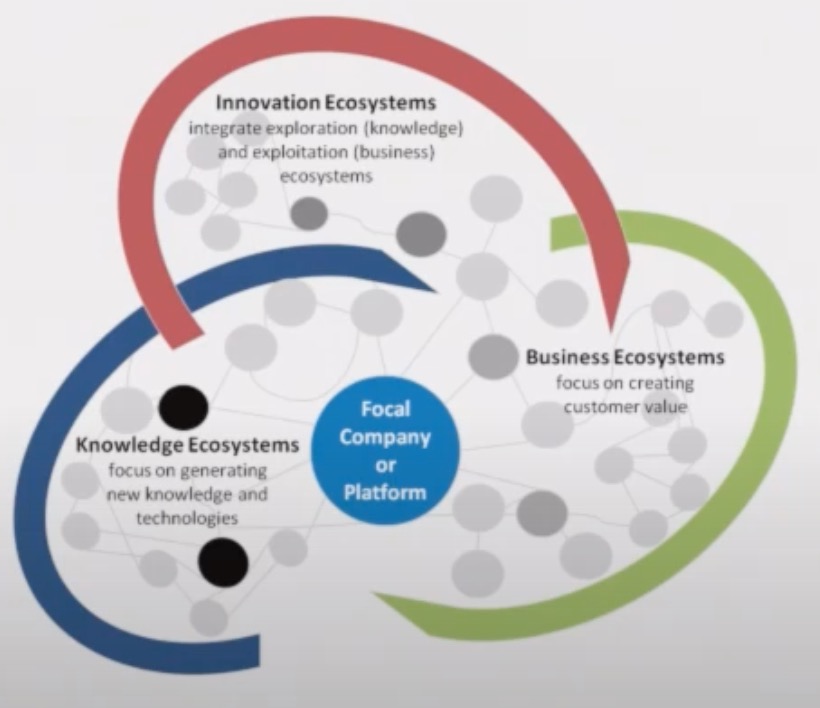The Concerted Action of Innovation Ecosystems

Professeur Michael G. Jacobides est titulaire de la Chaire en entrepreneuriat et en innovation à la London Business School (LBS) où il est enseigne la stratégie et l’entrepreneuriat. L’université LBS lui a accordé le titre de Sir Donald Gordon Professor en hommage à ce philanthrope et chef d’entreprise du domaine de l’assurance et de l’immobilier.
by Nicolas Sacchetti
Innovation ecosystems are the business model of the 21st century. Sir Donald Gordon Professor Michael G. Jacobides of the London Business School was on hand to address the importance of innovation ecosystems in the business world.
The event was held in May 11-13, 2021 at the P4IE Congress on Policies, Processes and Practices for Performance of Innovation Ecosystem organized by the 4POINT0 Partnership for Innovation and New Technology Organization.
The term ecosystem, Michael G. Jacobides says, was introduced by Sir Arthur Tansley (1935), who said that "The ecosystem comprises the organisms, and the set of physical factors forming what we call the biome environment (the great environments of the earth's globe) — habitat factors in the broadest sense." Yet, this is a term which is so broad, that, taken for business, can mean many different things – so, we need to be clear what we refer to.
For Prof. Jacobides, ecosystems describe changes in the reality of industrial and commercial enterprises. "The firms that make the most of ecosystems are those that produce the most capital," he says. A wide range of meanings is possible with this term.
For a given company or platform, he presents three types.
1- Business ecosystems are the most documented in recent literature. They consist of groups of firms coming together to create economic opportunities through enhancing the customer experience and offering choice.
2- Knowledge ecosystems focus on the generation of new knowledge and technologies, when there is a need for coordination.
3- Innovation ecosystems can also be regional and can be the contemporary version of “clusters” of collaborating firms. They integrate business and knowledge ecosystems.

Innovation ecosystems
Changing the Business Model
The largest firms — commonly known as GAFAMs — use different types of ecosystems in conjunction with each other in order to ensure their success. These predominantly digital and international products alter competition and affect regional development models.
"Ecosystems are those groups of things that work together, and that we need to coordinate, because focusing only on a product is no longer enough."
- Professor Michael G. Jacobides
Types of Business Ecosystems
- The fixed-core type (e.g., Nespresso) wants to find add-ons to become more attractive: a coffee machine and custom capsules to charge it.
- The transaction ecosystem (e.g., Uber) manages service offerings.
- The innovation toolkit type (e.g., Linux) is a specialization that focuses on creating a supportive community for software and the digital universe.
- The digital solution offering ecosystems (e.g., Alexa) collects a customer base with which it interacts. The company connects to all the services that subscribe to it, and creates the environment of possibilities for its customers; as the catalog of solution offerings grows, so do the profits.
Interdependence
Business collaboration provides value and choice to users. That's why ecosystems with multiple products require complementary ecosystems made up of players from different backgrounds. For example, Apple needs third-party applications to enhance its interfaces, and third-party suppliers to build its technology objects. Technology allows us to symbiotically connect different services to each other and create a range of possibilities that benefit customers. Although their choices are limited to the catalog of digital solutions offered.
Seven Steps to Structure an Ecosystem
1- Delineate the scope of the multi-product ecosystem, and explore the universe of possibilities where the firm can become a substantial player.
2- Understand the ecosystem landscape and the competitive position.
3- Analyze the role the firm should play in the business ecosystem and determine the strategic approaches to be implemented. The firm must ask itself the questions: Can I deliver the goods by myself, or do I need an ecosystem of multiple players? And if so, will I be the orchestrator or what will my role be? The orchestrator secures control by serving the customer with an integrated offering. The partner leverages additional sales channels from the orchestrator. The collaborator readjusts the business model to a business-to-business model allowing other players to do business.
4- From then on, the firm can analyze the potential value it could offer to the ecosystem.
5- Find the partners with whom it wants to associate, and how to attract them or be attractive.
6- Set up an ecosystem management system.
7- And finally, the company will be able to explain the investment case and choose which KPIs to track to make an ecosystem a reality.
Building a Great Ecosystem
Professor Jacobides gives his advice on the do's and don'ts of building a great ecosystem.
Do
- Pick your battles, have anchors, and partners to enlist.
- Obsess about the client and the processes they will have to undertake. If they prove too difficult, consider transferring them to someone more skilled at doing them.
- Co-create value by making strategic partnerships.
- Conduct proactive searches for collaborators.
- Realize that you can't do everything yourself. Have a game plan.
- Formulate your intentions.
- Know how to compete, prioritize, and thrive.
- Measure and reward success.
Don’t
- Thinking you can do everything yourself.
- Build an "egosystem" and assume that customers and partners will join you.
- Offer everything blindly, regardless of consumer choice.
- Treat your partners as suppliers. It's better to create in cooperation, no RFPs.
- Don’t rush things. Creating ecosystems takes time.
"As the world is moving in interesting and dynamic ways, the local entrepreneurial ecosystem is not the only thing we should look at, but the way that the local dynamics are embedded in the global business ecosystems is what’s going to thrive success." -Professor Michael G. Jacobides
This content has been updated on 2022-09-27 at 23 h 41 min.